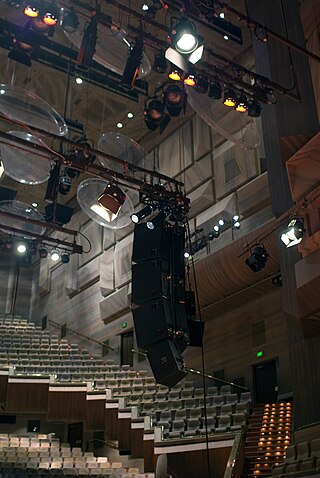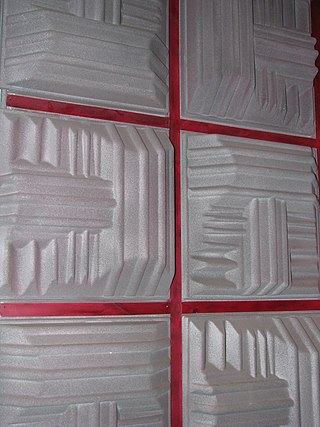
In atmospheric sounding and noise pollution, ambient noise level is the background sound pressure level at a given location, normally specified as a reference level to study a new intrusive sound source.

Noise is unwanted or harmful sound considered unpleasant, loud, or disruptive to hearing. From a physics standpoint, there is no distinction between noise and desired sound, as both are vibrations through a medium, such as air or water. The difference arises when the brain receives and perceives a sound.

Acoustical engineering is the branch of engineering dealing with sound and vibration. It includes the application of acoustics, the science of sound and vibration, in technology. Acoustical engineers are typically concerned with the design, analysis and control of sound.

Soundproofing is any means of impeding sound propagation. There are several basic ways to reduce sound: increasing the distance between source and receiver, decoupling, using noise barriers to reflect or absorb the energy of the sound waves, using damping structures such as sound baffles for absorption, or using active antinoise sound generators.
White noise is primarily a signal or sound with a flat frequency spectrum.
Underlay may refer to flooring or roofing materials, bed padding, or a musical notation.

The Barkhausen effect is a name given to the noise in the magnetic output of a ferromagnet when the magnetizing force applied to it is changed. Discovered by German physicist Heinrich Barkhausen in 1919, it is caused by rapid changes of size of magnetic domains.

A sound baffle is a construction or device which reduces the strength (level) of airborne sound. Sound baffles are a fundamental tool of noise mitigation, the practice of minimizing noise pollution or reverberation. An important type of sound baffle is the noise barrier constructed along highways to reduce sound levels in the vicinity of properties. Sound baffles are also applied to walls and ceilings in building interiors to absorb sound energy and thus lessen reverberation.
In acoustics, noise measurement can be for the purpose of measuring environmental noise or measuring noise in the workplace. Applications include monitoring of construction sites, aircraft noise, road traffic noise, entertainment venues and neighborhood noise. One of the definitions of noise covers all "unwanted sounds". When sound levels reach a high enough intensity, the sound, whether it is wanted or unwanted, may be damaging to hearing. Environmental noise monitoring is the measurement of noise in an outdoor environment caused by transport, industry and recreational activities. The laws and limits governing environmental noise monitoring differ from country to country.

Noise control or noise mitigation is a set of strategies to reduce noise pollution or to reduce the impact of that noise, whether outdoors or indoors.

A noise barrier is an exterior structure designed to protect inhabitants of sensitive land use areas from noise pollution. Noise barriers are the most effective method of mitigating roadway, railway, and industrial noise sources – other than cessation of the source activity or use of source controls.
An acoustic shadow or sound shadow is an area through which sound waves fail to propagate, due to topographical obstructions or disruption of the waves via phenomena such as wind currents, buildings, or sound barriers.

In filmmaking, Foley is the reproduction of everyday sound effects that are added to films, videos, and other media in post-production to enhance audio quality. Foley is named after sound-effects artist Jack Foley. Foley sounds are used to enhance the auditory experience of a movie. They can be anything from the swishing of clothing and footsteps to squeaky doors and breaking glass. Foley can also be used to cover up unwanted sounds captured on the set of a movie during filming, such as overflying airplanes or passing traffic.
Noise is any unwanted sound. More broadly, noise (spectral phenomenon) describes many types of random or unwanted signals, which are listed in that article with related topics.
Acoustic quieting is the process of making machinery quieter by damping vibrations to prevent them from reaching an observer. Machinery vibrates, causing sound waves in air, hydroacoustic waves in water, and mechanical stresses in solid matter. Quieting is achieved by absorbing the vibrational energy or minimizing the source of the vibration. It may also be redirected away from an observer.
Crackle or crackling may refer to:
This page is based on this
Wikipedia article Text is available under the
CC BY-SA 4.0 license; additional terms may apply.
Images, videos and audio are available under their respective licenses.








